Adam Young, who runs the Youngfolk & The Kettle Black coffee shop with his wife Rebekha, thinks about service – real, genuine, human-level service – quite a bit.
Adam told me once that he makes a real effort, when someone walks into the coffee shop on Richmond Street, to nod, to make eye contact, to say hello; he makes an extra effort to do this if the shop is busy and it will be a minute before he can make coffee for the newcomer.
The glance, the nod, the hello, the “we’ll be just a minute,” beyond being simply decent, breathes some air into the customer-server relationship and gives Adam some extra time to spend making every coffee right. This is no small feat in a business where caffeine-starved customers arrive in a rush and blunder.
I am a strong believer in the notion that all business, no matter whether coffee or Internet or steam shovel or blue jeans, is, fundamentally, communications business. This has never been more true than now, when many products and services are commodities you can get from anywhere: honest, open, frequent customer communication is often the only way that one business can stand out from another.
If I walked into Youngfolk on a busy day and Adam didn’t give me a wink and a nod, I’d feel something was wrong, and I’d feel doubly-injured, once for the lack of recognition itself and twice for the lack of anticipated recognition: when a business that’s good a communicating, that prides itself on communicating, has communications go awry, the corollary to “all business is communications” kicks in: it’s like your best friend has stopped talking to you. And you don’t know why.
This is what happened to me earlier this week when I got frustrated enough with Apple and its response to a broken MacBook Air to write a detailed blog post about the incident: I was frustrated because I wasn’t getting customer service satisfaction, and doubly-frustrated because I expected more from Apple.
Fortunately it’s possibly to repair off-the-rails communications disasters with some effective intervention, and that, I’m happy to say, is what happened this afternoon on the MacBook Air file.
Just before five o’clock, the phone rang, with the caller ID showing a 408 area code. “Who do I know in California,” I thought to myself as I answered the call.
“This is Mac calling from Tim Cook’s office,” said the caller.
Oh, that’s who I know in California.
Yesterday, you see, after writing my “Dear Apple” blog post, I sent a note to Tim Cook, Apple’s CEO, thinking, quite genuinely, that he should know when things don’t go right. I had some confidence that somebody – if not Tim Cook, at least somebody – would read of my plight.
Mac was calling to make sure things got back on track.
He’d read my blog post, had called Jump+ in Moncton, had a plan in place for me to drive over to Moncton and be assured that I could get a while-I-wait repair of the MacBook with a part waiting.
He was, in other words, on top of the situation.
And, more than that, Mac was an extremely skilled communicator, a sort of Jason Bourne of customer service intervenors: everything from the tone of his voice to the nature of his plan for us (yes, us – we’d be going through this together, Mac assured me) was equal parts warmth, professionalism and reassurance. If I was having a nervous breakdown, I’d want Mac on duty at the crisis centre to take my call.
So I’m driving over to Moncton on Friday to get Oliver’s MacBook Air fixed. I have no doubt that it will happen, and that I will be happy with the result.
And here’s the thing: that’s exactly the same thing I was going to do before Mac called, albeit in a pissed-off begrudged suspend-my-disbelief kind of way.
Adam Young isn’t in the business of selling coffee, he’s in the nod and wink “hey, Peter, how’s it going” business.
As is Apple, at least where service and support is concerned: it’s as important for me to feel good about the service and support I receive, to fell in control of the service and support I receive, and to believe in the quality of the service and support I’ll receive as it is to actually receive the service and support itself.
In a single 4 minute and 52 second phone call from California, Apple, through their man Mac, reestablished that confidence for me with Apple.
At the end of yesterday’s blog post I wrote “I will happily write a ‘wow, Apple knocked my socks off’ blog post when you come through.” This is that post. And I’m writing it now, even before the MacBook Air is repaired, because, to my mind, Apple’s on the job again.
The Province of PEI has a treasure trove of public GIS data available and using my GIS-data-grabber script you can slurp it all down easily to your local machine. Run that script and you’ll end up with a collection of ESRI shapefiles ready for exploring.
But what then?
What if you want to start using modern web-based GIS tools like OpenStreetMap and geojson.io?
Here’s what you need to do to take old-school PEI GIS data and make it web-tool-friendly (in technical terms, here’s what you do to transform the coordinate reference system of the GIS data from NAD83/PEI Stereographic to WGS84).
First, get the free Quantum GIS application and install it. Next, open a PEI shapefile in QGIS (Layer | Add Vector Layer). Here’s what the “bridges” shapefile looks like when I do that:
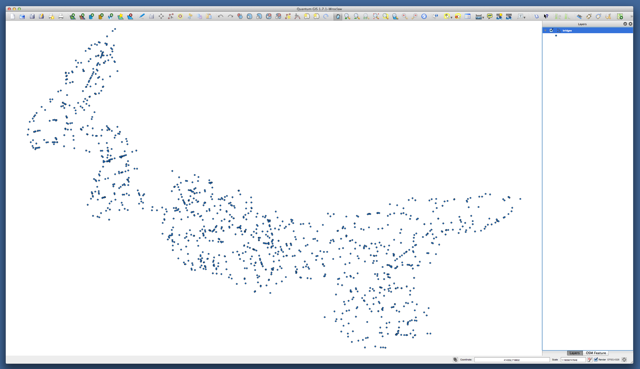
Next, right-click on the name of the layer – “bridges” in my case – in the list of layers in the sidebar and click Set layer CRS and select the coordinate reference system called NAD83(CSRS) / Prince Edward Isl. Stereographic (NAD83) and click OK:
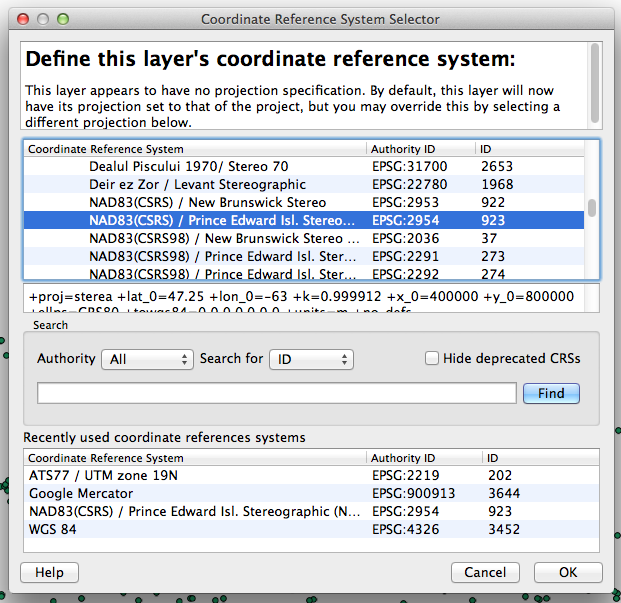
Then right-click again on the layer and select Save as… and click on the Browse button beside CRS:
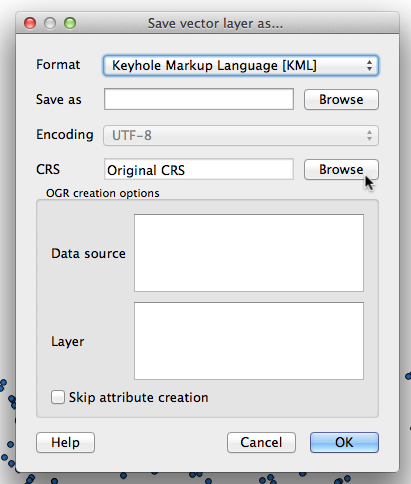
And for this export set the CRS for the layer you’re going to save to WGS 84 / EPSG:4326 and click OK:
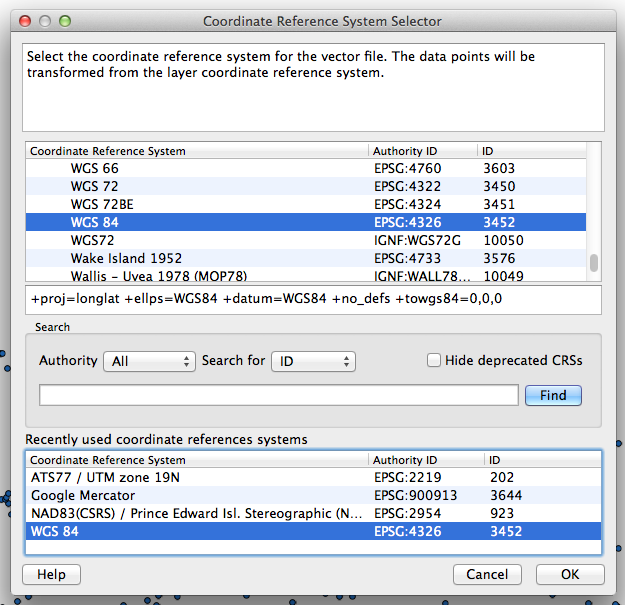
Then just select the format you want to export as: KML for Google Maps or Google Earth, GeoJSON for geojson.io, for example. You’ll now have a transformed version of the GIS data in the WGS 84 coordinate reference system ready for use.
And here’s a KML file of the same data that you can load into Google Earth.
From Olle comes a pointer to this great news from GitHub about supporting GeoJSON in Gist (keep reading if you’ve no idea what that means; I promise it gets better soon).
In that announcment post is a pointer to geojson.io, which is a fantastic project that means “here’s that great beach” and “when you visit park your car over hear” and “the best places for coffee are” maps is very, very easy, with the side-benefit of being very, very open under the hood. As Google Maps becomes ever-more-drenched in monetization opportunities and complexity this is evermore valuable.
Here’s a quick guide to making your own map. Please try this out yourself!
Let’s say I want to tell my friend Ray where to find Youngfolk and The Kettle Black in Charlottetown.
I open up a web browser and go to http://geojson.io/ and click on the search icon in the top-left and search for “Charlottetown” and then click on “Charlottetown, Prince Edward Island” in the results:
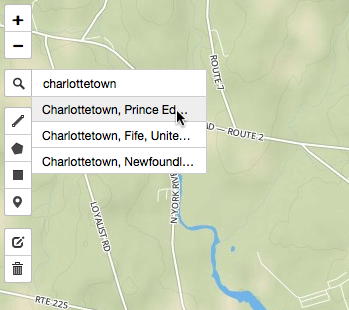
This zooms the map in to cover Charlottetown. I can then zoom in further to locate Youngfolk on Richmond Street. Once I’m in the area I click on the “marker” icon to add a marker to the map:
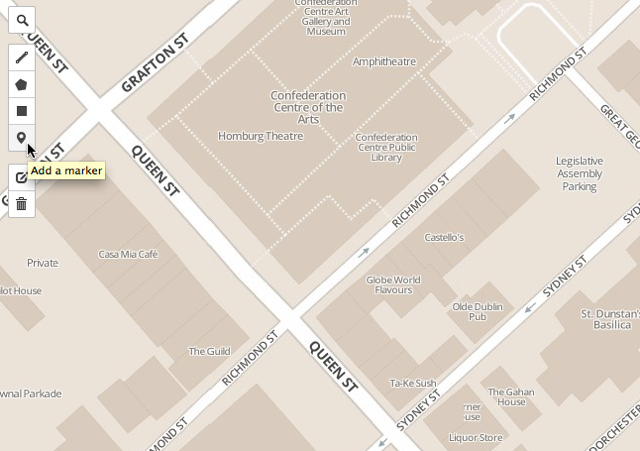
I then move my mouse out onto Richmond Street and click it on the spot where I want to leave a marker:
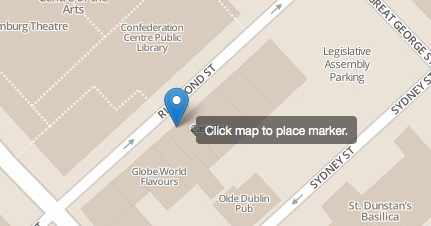
Once I’ve dropped the marker there, I click on the marker to allow me to add a name; I add the name and click Save:
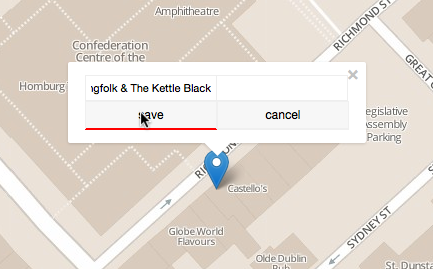
That’s it: you’ve made a map. Now you can spread it around: click the “Share” button in the top-left for your options:
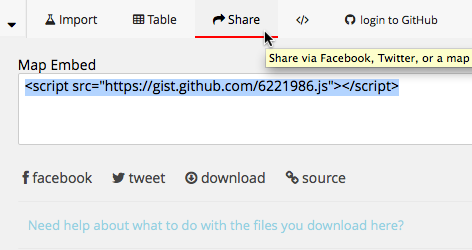
By default you’ll be given HTML to paste into a web page.
But you can also share by Facebook or Twitter, or just copy-and-paste the URL from the browser’s address bar into an email:

Hey Ray,
Check out this great coffee shop in Charlottetown:
http://geojson.io/#gist:anonymous/6222023
Cheers,
Peter
It gets even more fun, though: click on the button in the top-left and you’ll see the source code for your map in GeoJSON form:
{
"type": "FeatureCollection",
"features": [
{
"type": "Feature",
"properties": {
"Youngfolk & The Kettle Black": ""
},
"geometry": {
"type": "Point",
"coordinates": [
-63.126325607299805,
46.234017721208055
]
}
}
]
}
You can use the source for all manner of interesting things.
Sending coffee directions easily is cool, but it starts to get really interesting when you think about the possibilities for using GeoJSON and geojson.io as DIY GIS tools. Here’s a map of all the public schools in Prince Edward Island.
Notice the fact that Spring Park Elementary is in the wrong location? You can take the raw GeoJSON, correct the location, and create your own update Gist for a corrected map.
Here are the tables from the 1975 Island Tel directory listing the cost of making “station-to-station” and “person-to-person” long distance calls to Canada and the United States. Wikipedia summarizes the two call types nicely:
- A person-to-person call is an operator-assisted call in which the calling party wants to speak to a specific party and not simply to anyone who answers. The caller is not charged for the call unless the requested party can be reached. This method was popular when telephone calls were relatively expensive.
- Station-to-station is a method of placing a telephone call, with or without assistance, in which the calling party agrees to talk to whoever answers the telephone.
On the Canadian chart the rates are per minute, with a one-minute minimum; the most expensive station-to-station call you could make was during the day from Monday to Saturday from Charlottetown to Manitoba or west for 95 cents a minute. This call would cost you $57 if you talked for an hour.
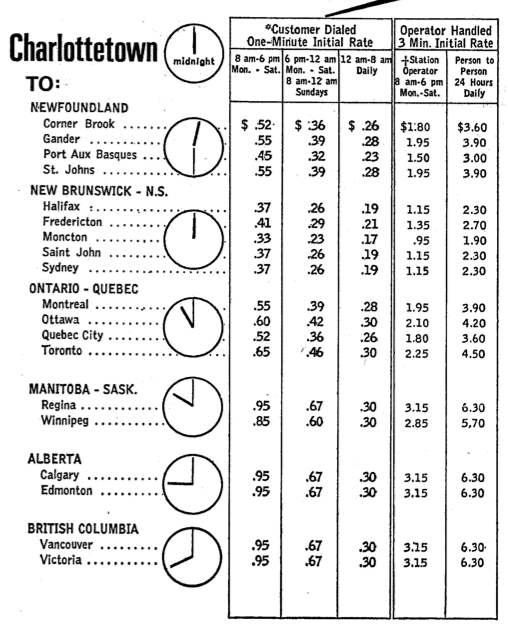
On the USA chart the charges are for a minimum 3-minute call, so you divide by three to get the per-minute rate. The most expensive call you could make within Canada and the United States in 1975 was to the west coast of the USA which, during the “prime time” of 6:00 a.m. to 6:00 p.m. would cost you 91 cents a minute, or $54.60 an hour.
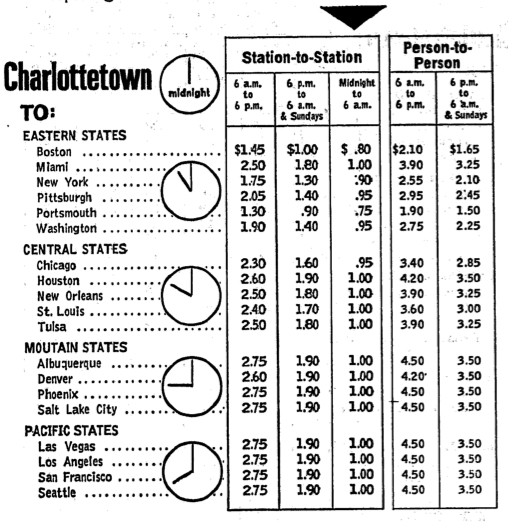
Right now, 38 years later, the most expensive “station-to-station” call I can make is the $9.29 a minute ($557 an hour) it would cost me to call an Immarsat Atlantic phone.
But that’s an exception to what, otherwise, are frightfully low rates by comparison.
For the same 91 cents a minute I could call Seattle for in 1975, I can now call a mobile phone in Romania or a land-line in rural Chile.
For 80 cents a minute I can call Easter Island, Kiribati, or a mobile in Greenland.
For 50 cents a minute I can call a mobile in the Morrocan desert or land line in Senegal or Djbouti.
For 10 cents a minute I can call mobiles in the Czech Republic, Australia and Brazil and land lines in Bolivia.
And for a penny a minute – 1 cent! – I can call land lines in Korea, Turkey, Mexico, Brazil, and Taiwan and mobiles in India.
Calling someone at a penny a minute means that staying on the line for 24 hours would cost you about $14. Which is the same amount you could have spent in 1975 on a 15 minute call to Vancouver.
What I find facsinating about all of this is that for people of my generation and older this dramatic decrease in the cost of long distance has never really hit home: we still have, buried deep our our subconcious, the impulse to “wait until after 6” to call (for better rates) and the sense that calling anywhere beyond Summerside is something that you have to be careful about because you could go broke.
For me to pick up the phone in my office right now – in the middle of the day! – and call my friend Olle on his mobile in Sweden would cost me 5.5 cents a minute. And yet I would never, ever think of doing that. Even trans-Atlantic Skype, with no per-minute fee, seems exotic and like it must be rationed.
“Economic sense memory” is long-lasting and hard to shake: it’s why my grandmother would walk up the hill to Callbeck’s in Brantford to save 5 cents on yogurt when it was on sale; she came of age in the depression and saving 5 cents was something she would never pass up the chance to do, no matter how far she had to walk or how much time it took out of our day.
I’m pretty sure that Oliver has no notion at all of what “long distance rates” are: he’s been video chatting with his grandparents his entire life, and thinks of instant global communication as he thinks about shouting across the street. He’s shaken the curse. And that’s probably a good thing.
A little more detail about the new design of the Youngfolk & The Kettle Black coffee bags (which are now available at the Richmond Street location to hold your pound of coffee, should you wish).
The ungainliness of the coffee bags themselves makes them more difficult to print than simpler items: the press has to go through 4 rotations for me to set a bag in place, print it, set the throw-off lever so that it will stop printing, remove the bag, set it aside, and repeat. As such it took about an hour to print 80 bags, about 45 seconds per bag.
The quote comes from a book, All About Coffee, by William H. Ukers, digitized by Project Gutenberg and originally published in 1922 by “The Tea and Coffee Trade Journal Company” in New York, of which Ukers was editorial director.
The body copy is set in 24 point Futura, the “Y&TKB” is set in 60 point Akzidenz Grotesk.

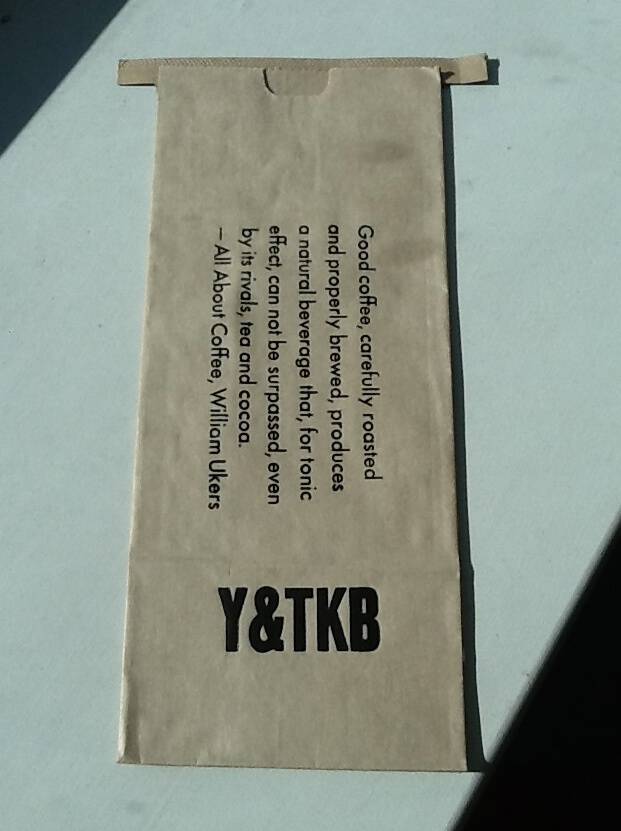
Dear Apple,
Just under a year ago we bought a MacBook Air for my son Oliver. He was 11 at the time; he’s 12 now. It’s a great little machine, and it served him well in school all year long. I refer to it as his “prosthetic device,” as it’s an invaluable tool for almost everything he does.
We bought the computer from Little Mac Shoppe, an authorized Apple dealer and service centre here in Charlottetown, Prince Edward Island. It would have been easier and faster and maybe even a little cheaper to buy it online, or to buy it from a big-box store at the edge of town, but we wanted to support our local dealer, and as it was steps from both our home and my office we knew that service would never be far away.
Unfortunately a few months after we bought the MacBook, the Little Mac Shoppe went out of business; we were sad to see them go, but rested easy in the notion that Apple’s world-class support would keep us going if anything went wrong during our 1-year warranty period. Several earlier experiences with Apple support had been universally positive, and I’d no reason to suspect that this had changed, Little Mac Shoppe or no.
 Yesterday afternoon Oliver went to turn on his MacBook and was faced with a grey screen and a flashing question mark inside a folder; the computer wouldn’t boot.
Yesterday afternoon Oliver went to turn on his MacBook and was faced with a grey screen and a flashing question mark inside a folder; the computer wouldn’t boot.
After trying the recommended steps on your support website, I contacted your 1-800 number, as I knew it was still under warranty and it seemed pretty clear it was a hardware issue.
At first the technician I talked to said he couldn’t help me: I needed to take the MacBook to an Apple store for diagnosis and possible repair. When I explained the the nearest Apple Store is 4 hours away in Halifax, Nova Scotia he put me on hold, and he came back a few moments later and said he’d received special permission to help me because of this.
The tech guided me through the same steps I’d already followed online, and at the end of this process he confirmed that this was likely a hardware issue, and that I should take the MacBook into the Apple Store in Halifax for repair.
When I asked if there was another option available to me – a mail-in repair, for example – I was told this wasn’t possible in Canada, and that my only recourse was to drive the 4 hours to Halifax where the repair could be done while I waited. He advised to call before leaving to confirm that the part was in stock.
So tonight I called the Apple Store in Halifax to confirm that the required part was in stock.
And I was told that they cannot confirm whether parts are in stock over the phone, and that my only recourse was to come to the store and hope for the best. When I explained that this could mean driving for 4 hours in each direction for nothing, I was offered no recourse.
Wanting to avoid the chance of driving to Halifax for nothing, I called Apple Support again, and talked to a very friendly fellow who, on hearing my story, sympathized with my plight, and said there would be no problem doing a mail-in repair: I’d receive a pre-paid box to ship the MacBook in, and it would be quickly couriered back to me.
Then he took my postal code and his system told him that a mail-in repair wouldn’t be possible. He put me on hold to consult with someone else and when he came back he confirmed that no mail-in option was available because of where I was located (he wasn’t clear whether this meant where in Canada, or simply that mail-in repairs weren’t available in Canada at all).
He offered, as an alternative to driving to Halifax, the option of driving to Moncton, New Brunswick to Jump+, an authorized service depot. He assured me that depots like this can order parts in advance so as long, as I called before I came, I could make sure the trip wasn’t for nothing.
So I called Jump+. Spoke to a very helpful fellow who told me that they don’t generally order parts in advance, but because I was a long drive away they could make an exception, but that they could only hold the part “on lawaway” for 24 hours before it would need to be returned, so I’d have to specify exactly when I’d be coming. I was told that the service technician would call me in the morning, but cautioned that he might not do this because he’s very busy, and I might need to call him.
So, right now, that’s the working plan.
This isn’t good enough.
You sold me something that broke. It’s your fault. I have a warranty. Based on previous experiences I expected you to honour that warranty quickly and painlessly.
What’s changed?
As a company concerned with service and the customer experience to the extent that you are, two phone calls, a variety of stories, and a “definitely maybe” in Moncton simply isn’t enough: you should be working hard to help me help my 12 year old son (a son who’s now worried that his laptop won’t be fixed before school starts).
All of this leaves me with a bad impression of Apple, writing a bad-impression-of-Apple blog post that I would rather not be writing.
If you’d like to make this right, my case number is 490920122; I will happily write a “wow, Apple knocked my socks off” blog post when you come through.
Your friend and longtime-admirer,
Peter
Postcript: Read This is Mac calling from the Office of Tim Cook to see how Apple did come through.
After sitting with this coffee bag design for a while, I reconsidered the layout, moved the type around, and ended up with this for the final design:
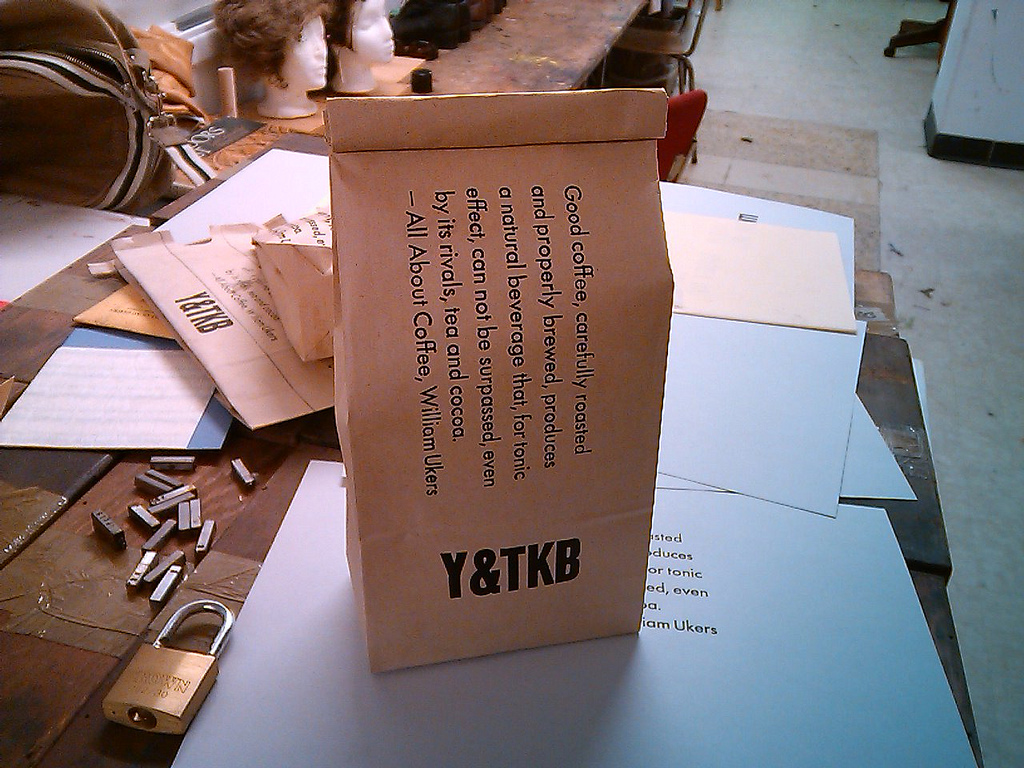
(I don’t know my my camera took a photo that makes the type appear to glow, but it doesn’t).
I like this design much better: it elevates the Y&TKB to prominence, fills up what otherwise would have been a vast expanse at the bottom of the bag, and leaves a pleasant amount of whitespace around the quote1 (which comes from All About Coffee, digitized by Project Gutenberg).
And it just looks better in that way that things do.
They’re off the press and drying as I type.
1. Here’s the complete sentence, if you’re interested:
Good coffee, carefully roasted and properly brewed, produces a natural beverage that, for tonic effect, can not be surpassed, even by its rivals, tea and cocoa. Here is a drink that ninety-seven percent of individuals find harmless and wholesome, and without which life would be drab indeed—a pure, safe, and helpful stimulant compounded in nature’s own laboratory, and one of the chief joys of life!
It’s good to take a coffee bag design out for a ride, to experience how it looks when it’s filled with coffee (or, in this case, rags standing in for coffee) and folded up and out in the wild. So I packaged up a sample and took it down the street and had a coffee and looked at it on the shelf. Still pondering.
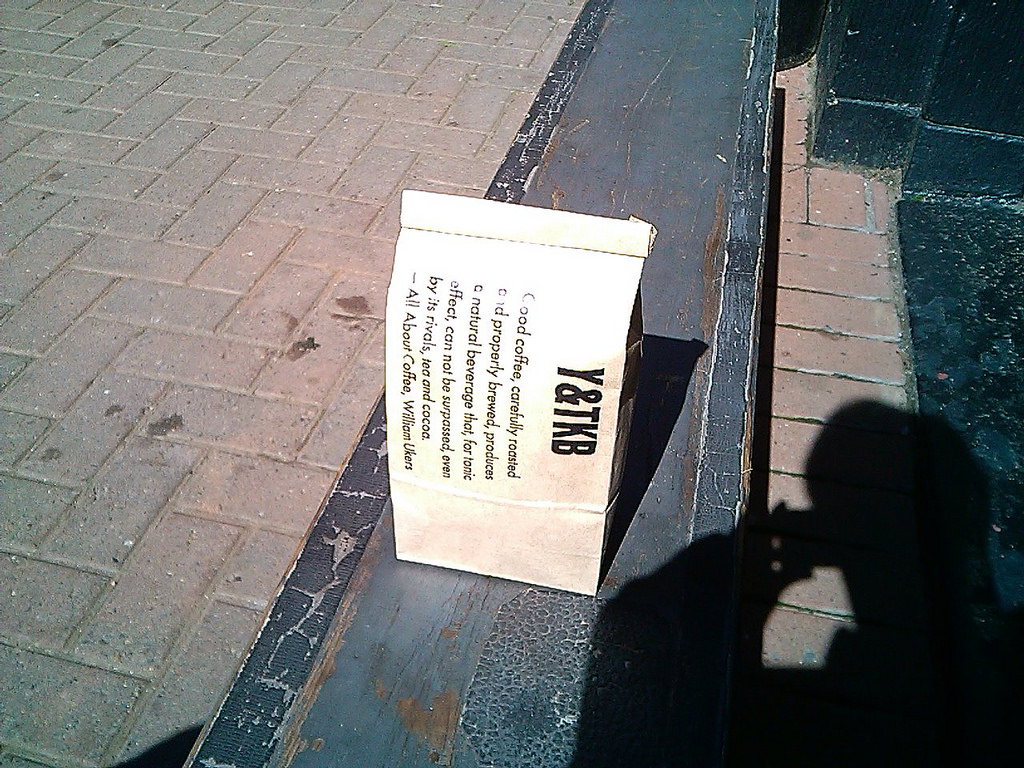
 On a cool summer night last year I joined a couple of dozen other people in Kings Square in Charlottetown to watch WOLVES > BOYS, one of the shows the 2012 edition of The Island Fringe Festival. It was a witty little play, well-acted, and the venue couldn’t be beat.
On a cool summer night last year I joined a couple of dozen other people in Kings Square in Charlottetown to watch WOLVES > BOYS, one of the shows the 2012 edition of The Island Fringe Festival. It was a witty little play, well-acted, and the venue couldn’t be beat.
As such, I was well-primed when a request appeared in my email box last week, through a carefully-choosen intermediary, asking me to be a sponsor of this year’s festival. I wrote a cheque – a modest $200 cheque, mind you, not a life-changing Tim Banks-style cheque – on the spot. As such I become a “Community Sponsor” of this year’s fringe. Or rather Reinvented does.
The sad irony is that I’ll be away in Ontario for the duration of this year’s festival – August 29 to 31, 2013 – and so I won’t get a chance to enjoy the walk-on roles, skyboxes, VIP lounge access, extravagant afterparties, and other perks that such sponsorship affords1.
If you happen to have a few hundred dollars kicking around and an urge to support independent theatre in unusual venues, perhaps you could become a sponsor too? Just go here and follow the links.
1. I exaggerate: the perks of “Community Sponsorship” are a more modest “logo on Island Fringe Festival website, recognition of your business on Island Fringe’s Facebook and flyer included in welcome packet for Island Fringe Festival artists and volunteers.”
2. Post title courtesy of Rogers & Hammerstein’s “Oklahoma,” The Surrey With The Fringe On Top.
I was searching about yesterday looking for some information about the DRM system that Overdrive uses to lock up ebooks it makes available to public libraries (including Prince Edward Island’s Library Service, which is a customer).
One of my searches was “how to share Overdrive books” and this search led me to an intriguing-looking slide in a PowerPoint presentation for client libraries:
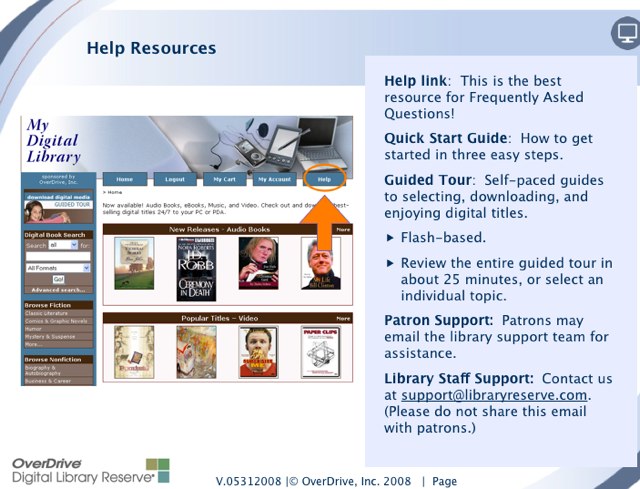
Anything labelled “please do not share this email with patrons” is prone to make my eyes perk up, and so I read the PowerPoint presentation from beginning to end. It turns out to be a good overview of Overdrive’s offerings for libraries (which, regular readers may recall, I likened to “crazytown” on national radio).
The next slide in the deck was even more interesting than the eyes-only email address; it concerned the reports available to client libraries:
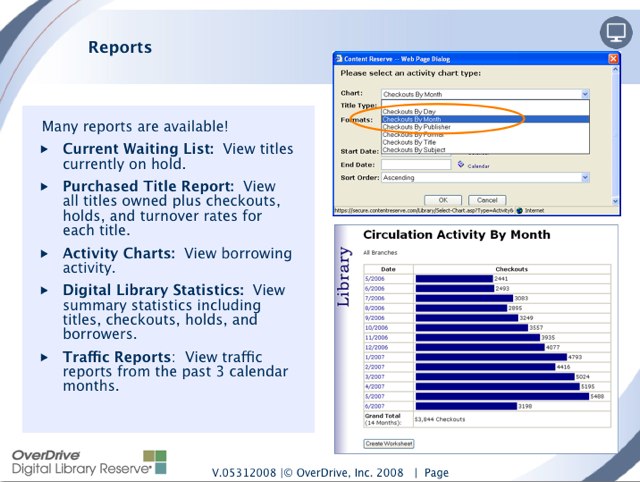
“Cool!”, I thought to myself as I fired off an email to the always-helpful librarians at the Provincial Library’s Fortress of Solitude in remotest Morell. I quickly got a reply. Here’s what I learned:
- Separate and apart from Overdrive, currently there are 48,751 adult library cards and 17,876 children’s library cards for a grand total of 66,627 library cards in service. (By my own calculation, that’s almost exactly 50% of the adult population holding a library card).
- The Provincial Library Service subscribes to Overdrive’s “One Copy/One User” product – this is the aspect of the service that meant that while I had “checked out” a Teach Yourself Norwegian book nobody else in PEI could borrow it.
- The Library Service has 5,246 digital items in its collection (read “licenses 5,246 items for one-at-at-time circulation to PEI patrons”): 1,309 audiobooks, 3,931 ebooks and 6 music items.
- Since May 2011, 3,847 patrons have checked out a digital title (about 8% of total patrons if you only count adults, 6% if you include children).
- Those patrons have “borrowed” a total of 9,581 audiobooks and 42,268 ebooks for a total of 51,849 digital items borrowed.
- Today (August 8, 2013) there are 546 patrons with digital items checked out and 587 items on hold.
- The PEI-branded Overdrive.com site has been receiving an average of about 5,000 unique “active visits” (not sure what distinguishes that from “unique visits”) a month over the last three months (May to July of 2013).
Here’s what the Overdrive.com registrations-per-month look like (patrons must register with Overdrive.com to “check out” items):
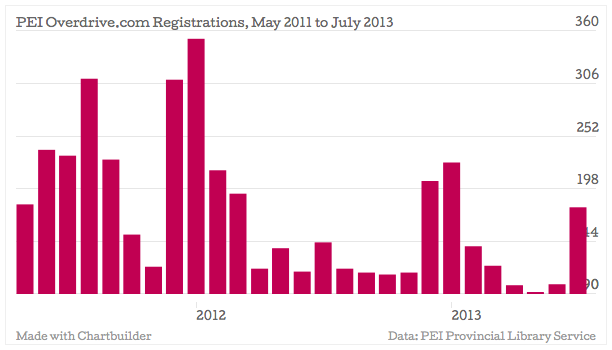
(That chart was made with the really-easy-to-use Chartbulder, which I recommend for all your spur-of-the-moment chart-making needs).
So, it would seem, ebooks and audiobooks are popular with we Islanders; what we need to work on next is making the experience of borrowing digital content less 1955-like.
 I am
I am